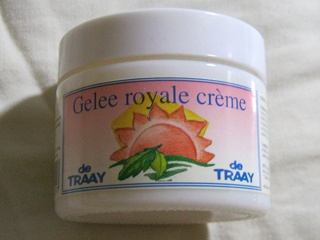
This is more a product comparison than the usual tech stuff, but it's still one of those bits of info someone might find a use for. Preamble: from earliest infancy I was heavily plagued with eczema, from dry scabby skin, to itchy rashes made up of pustules so tiny I had to strain my eyes to see them in the mirror, to weeping eczema when these pustules exploded like little volcanoes, producing watery discharge that hardened into a sickly-yellow crust. The doctor's answer was corticosteroid creams of increasing strength. The last brand I used was not supposed to be used for more than a few weeks, yet I'd been applying it for years.
After I left home, the condition soon cleared up "all by itself", because its root cause - living in a toxic environment - had gone. I did have the occasional outbreak, especially on my scalp, for which whatever GP I was seeing would prescribe me some hydrocortisone solution. Later, I used zinc-based ointment for any beginnings of a rash. After years of being told "it's constitutional" and I'd never get rid of it, information on the internet about "adrenal fatigue" showed me its real cause. The names of the various ointments and suspensions I'd been treated with - antihistamine, corticosteroid, hydrocortisone - all boil down to one thing: artificial cortisol.
The adrenal glands produce mainly two hormones: adrenalin (I believe it is now officially called something else, but will stick with the name everyone knows) and cortisol. What adrenalin does, is well known. Cortisol counteracts the effects of adrenalin, breaks down tissue and has a soothing effect on inflammations. Since the body itself causes inflammations whenever it suspects a pathogen has entered - a common example of this is hay fever - a person low on cortisol will have rashes and swellings all over, which will miraculously heal up when cortisol is administered. Adrenal fatigue is a condition where the adrenal glands, due to stress or physical ailments, can no longer produce enough cortisol (among other things), and so, for years, I'd been taking cortisol supplements through my skin.
This discovery seemed academical at the time I made it, since the last rash had been years ago. It continued to be academical until some ten years later, when I had strangely irritated eyes. It felt as if my eyes leaked tears into the outer eye corners, where they dried up into stinging little salt crystals. Eyes always leak a tiny bit of fluid, and I had the crow's feet of old age, meaning lots of folds for the leakage to get caught in. So I washed my face thoroughly and applied vaseline to the eye corners to waterproof them. This didn't help. So I scrubbed off the vaseline and took a good hard look in the mirror. There they were: tiny pinprick pustules.
As said, cortisol breaks down tissue, which is why it's bad for the skin,
especially skin that's already thin and aging. So I didn't feel like reporting
to the current GP for another tube of cortisol cream. Zinc-based ointments tend
to be too thick and greasy to be comfortably applied around the eyes, so I
surfed for and quickly found a page on natural alternatives to topically applied
hydrocortisone which listed chamomile, marigold (Calendula) and liquorice.
Then, I searched www.deonlinedrogist.nl, a Dutch online pharmacy, for
creams, suitable for use around the eyes, containing any of these ingredients.
The four most promising finds were:
Eucerin Kalmerende Gezichtscreme 12% Omega (Eucerin Soothing Face Creme 12%
Omega), a 50ml tube, price E18,99
Barefoot SOS Face & Body Rescue Creme, a 25ml tube, price E8,95
Jacob Hooy Zeven Kruiden Creme (Jacob Hooy 7 Herbs Cream), a 250ml pot,
price E7,95
Weleda Huidcreme (Weleda Skin Cream), a 75ml tube, price E9,89
What's noticeable is the price difference: the Eucerin cream is the most expensive per ml, closely followed by the Barefoot cream, of which I ordered the smallest tube by way of sample. The Weleda cream is half of that, and the Jacob Hooy cream is ridiculously cheap. These prices reflect the quality of these creams when it comes to treating rashes. Now, about their contents:
Eucerin, a French product, contains Licochalcone, a liquorice extract, and omega oils said to benefit the skin. It doesn't list all its ingredients, but contains no colorants and is not scented. It is suitable for sensitive skins and explicitly meant to help with eczema rashes and the resultant dry, red, itchy skin.
The Barefoot cream also doesn't list all its ingredients, but does boast botanical extracts, essential oils of chamomile and neroli, organic sulphur and natural moisturizers. A natural panacea, it helps against dry skin, rashes and insect bites. It can be used for all skin types and, as is cautiously stated, might be suitable for skins prone to eczema and psoriasis.
As the name suggests, the Jacob Hooy 7 Herbs cream, a Dutch product, contains extracts of seven plants: chamomile, southernwood, rosemary, yarrow, horsetail, parsley and stinging nettle, plus calendula and general cream ingredients, excluding artificial additives. Suitable for any skin type, it is said to make the skin silky smooth, so it's more for rehydration than against rashes.
Weleda, a German product, also has a complete list of ingredients that excludes artificial additives, but its star components are chamomile, calendula and pansy extracts in a greasy base of beeswax and almond oil. It claims to soothe sensitive skins, cure minor skin problems and rehydrate skins that are dry and flaky.
While waiting for the over-the-counter remedies to be delivered, I made good use of an old box of chamomile tea by soaking the teabags in hot, not lukewarm, water and putting them on my eyes. Once the teabags were completely cooled down, I'd toss them in the compost bin and thoroughly wash the skin around the eyes, scrubbing the flakes off, then apply vaseline. This was repeated whenever the itch became really bad, ie. several times a day.
On arrival, I tested the creams by using them alternately and in different spots. I also had to keep scrubbing around the eyes several times a day, as skin that suffers from eczema may start to flake rapidly in an effort to ditch what's irritating it, but the skin flakes become irritants themselves, and stop the cream from getting to the living skin that it's supposed to act on.
Eucerin comes in a plastic tube with a nice small opening, that won't squirt out too much cream. The skin rapidly absorbs it. At first, it didn't seem to help, but I've found it to be the most efficacious one of the lot, even if it took a few weeks. It's only meant to be applied twice a day, but as the rash was beginning to spread down to my ears and chin, I reapplied it whenever the itching became too bad. I ended up ordering a second tube.
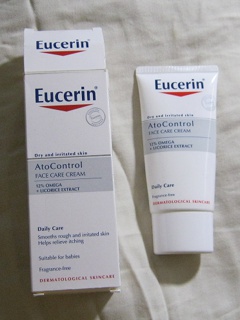
Barefoot comes in a tiny plastic tube with likewise a small opening, but although it may be good for stinging nettle rashes and I've later used it on mosquito bites (which, on me, tend to swell to the size of Euro coins), I would never use it on eczema again, especially around the eyes. It burns! Its stinging menthol effect helps with insect bites by making them stop itching, so they won't get worse from being scratched. (Using it on skin that is not cracked or scratched open is much less painful. Maybe it's the sulphur?)
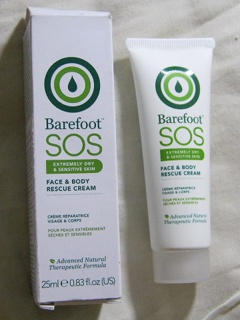
Jacob Hooy's product comes in a blue bottle that I called the "splortch-bottle", since an attempt to squeeze a small amount of cream out of the bottle resulted in a "splortch" and a big white blob in the palm of my hand that was enough to cover my face, arms and legs; I've since learned to put my finger against the opening, hold the bottle upside down and use whatever gets stuck to my fingertip. The instructions for use recommend applying it to the still moist skin after washing or showering, but a dry skin will also absorb it, although not as quickly and completely as the Eucerin cream. Given the quantity you get for the price, it's obviously more of a body lotion, and it neither soothed nor hydrated my face. Moreover, the inclusion of all these wholesome herbs gives it a certain barnyard smell.
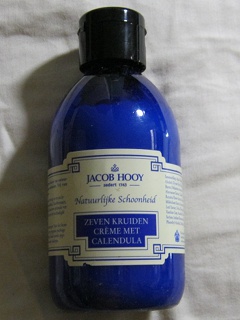
Weleda's cream comes in a large green aluminium tube shaped like a tube of toothpaste. Including not only beeswax and almond oil but also lanolin, an oil that genuinely helps to repair dry, cracked skin, it is of course extremely thick and sticky, lying on top of the skin like a night cream rather than being absorbed by it. If I used it all over my face and needed to wear glasses, I had to rub my nose clean with tissue paper first, and if anything happened to make me sweaty, the sweat, caught under the sticky layer of cream, would irritate my skin, and I'd have to wash everything off again. At first I got the impression that applying this cream around the eyes made the lower eyelids swell, but then I found that the eyelids would swell at random times, probably depending on how irritated my eyes were and how often I rubbed them. Whether this cream really helps against rashes, I'm still unsure, but apart from the discomfort caused by its greasiness, it really does help against the associated cracking and flaking. I ended up alternating between Eucerin and Weleda to combine their effects.
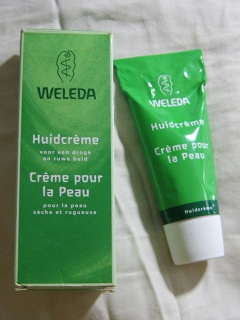
Another product that I tried is the Royal Jelly Cream with Propolis and Honey of the Dutch brand "de Traay", of which I still had a pot lying around. It contains both royal jelly, that famed concentration of nutrients, and propolis, a form of beeswax with antiseptic properties. Unlike the average skin cream, whose consistency, as the name suggests, is creamy, this bee product cream, when applied, felt like wax in water (it looks smoothly blended, but doesn't feel that way) and, after a while, would start to feel like a dried-up layer of wax on the skin. Like vaseline, it stayed sticky until washed off. Although supposedly for all-over-body use, it only really seems comfortable as lip balm, or hand cream for rough dry hands. I used it as a supposedly healthier alternative to vaseline for waterproofing (or tear-proofing) the eye corners, but didn't notice any special health benefits.
